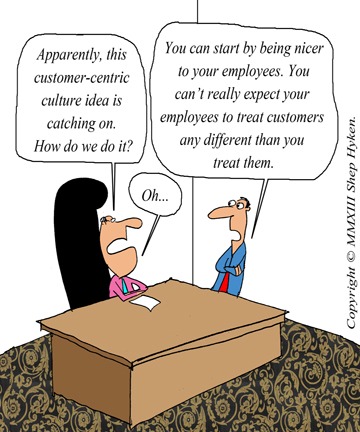 Customer Service Culture
Customer Service Culture
How do you create a customer-centric culture? Start on the inside, with employees. I’ve written and blogged a lot about this, and if this subject is important to you, I hope you’ll read some of the articles on CustomerServiceBlog.com. In the meantime, here is a list that will help you create a customer-centric culture:
- Define the customer service culture. This is where customer-centricity begins. Start with the end in mind. What does the perfect customer service experience look like for your customer? From there, determine what will deliver that experience.
- Communicate the culture. Do your employees really understand or know what your culture/vision is all about? Make sure it is simple enough for all employees to understand – even memorize.
- Hire to the culture. You have to have the right people in place; people who have both the skills and the attitude to take care of the customer. But there is more. You also need employees who have the personality that is in sync with the culture. That’s different than attitude. Don’t confuse the two of them.
- Train to the culture. You may have hired great employees, but regardless of their amazing backgrounds, if you don’t train them to your company’s culture, you can’t expect that they will be great for your company. Start training right away, focusing on the soft skills; your customer service expectations and your core values.
- Everyone must participate in the training. Everyone, and that includes the leadership of an organization, must participate in the training. Think of the negative message that might be perceived if leadership is noticeably absent from customer service training, especially if it is being touted as something extremely important to the company.
- Model the behavior. Everyone must step up and be a role model for others to emulate, especially leadership. Treat each other with the same respect and dignity as you would the customer – maybe even more so.
- Empower everyone to be a customer service leader. Once you define your customer service standards, don’t encumber your employees with rules that get in the way. Instead, give them the power to do what it takes to meet and exceed those standards.
- Recognize others when they do it well. Let people know they’re doing a great job. The recognition may be the motivation they need to continue, or even better, to take it to the next level.
- Defend the culture when necessary. It is everyone’s job to defend the company’s culture. If someone is not acting in sync with the customer service standards, you have a teaching opportunity. Grab it and use it to help the employee grow to be more successful in the future.
- Celebrate success. When it is all working, let your people know. Employees love to be appreciated and respected. Celebrate when they are doing a great job. That doesn’t mean a party every week. It may be recognition at a weekly meeting or a mention in the company newsletter. Or, maybe it is something big, like an annual awards dinner.




Shep has beautifully touched upon some important aspects od customer centric culture in organizations,Customer, continuous communications , connectivity , clarity are some of the strong pillars of strategy for business growth in the present competitive environment.21ST CENTURY BELONGS TO TECH DRIVEN CUSTOMERS.every organization must plan suitably in this direction.
Appreciate the kind words. Glad you enjoyed the article.